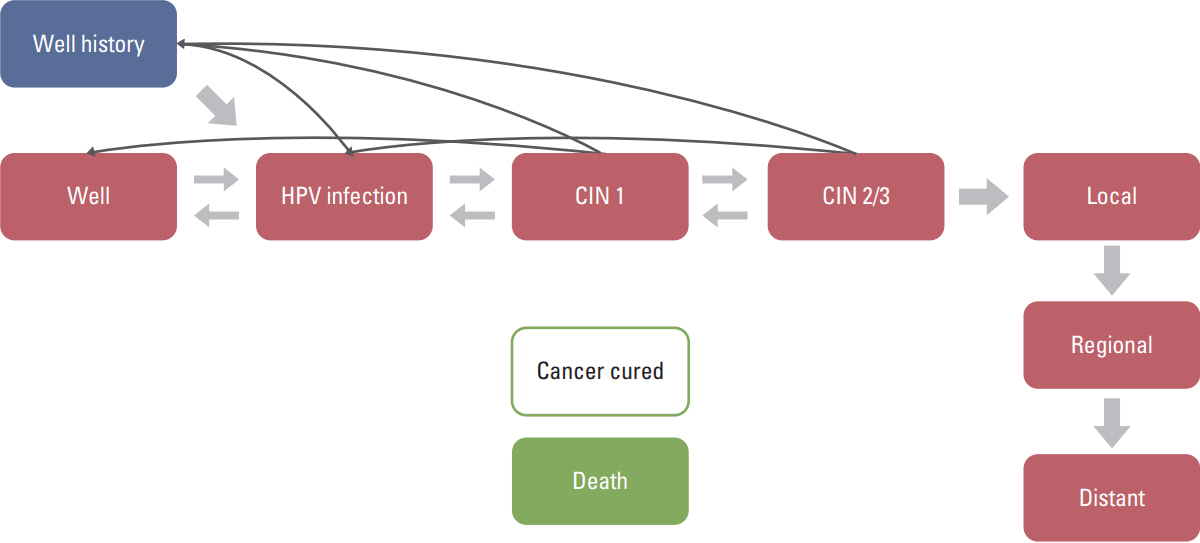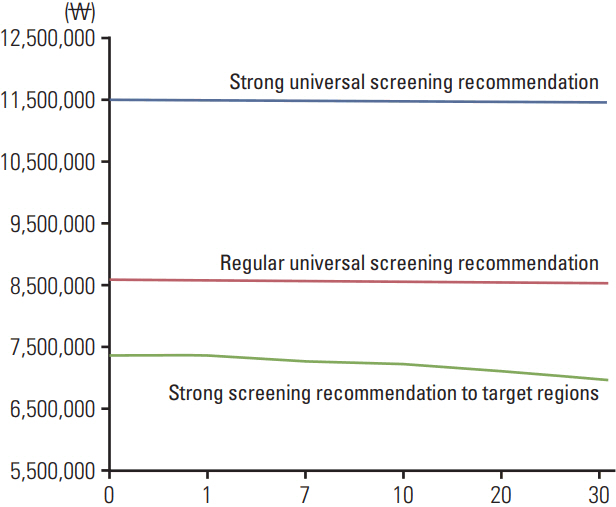Cancer Res Treat.
2018 Jan;50(1):212-221. 10.4143/crt.2016.525.
Strategic Distributional Cost-Effectiveness Analysis for Improving National Cancer Screening Uptake in Cervical Cancer: A Focus on Regional Inequality in South Korea
- Affiliations
-
- 1Department of Public Health, Graduate School, Yonsei University, Seoul, Korea.
- 2Institute of Health Services Research, Yonsei University, Seoul, Korea. THKIM@yuhs.ac
- 3Department of Preventive Medicine, Yonsei University College of Medicine, Seoul, Korea.
- 4Graduate School of Public Heath, Yonsei University, Seoul, Korea.
- KMID: 2403491
- DOI: http://doi.org/10.4143/crt.2016.525
Abstract
- PURPOSE
The purpose of this study was to conduct a cost effectiveness analysis of strategies designed to improve national cervical cancer screening rates, along with a distributional cost effectiveness analysis that considers regional disparities.
MATERIALS AND METHODS
Cost effectiveness analysis was conducted using a Markov cohort simulation model, with quality adjusted life years as the unit of effectiveness. The strategies considered were current (biennial Papanicolaou smear cytology of females aged 20 or above), strong screening recommendation by mail to target regions (effect, 12% increase in screening uptake; cost, 1,000 Korean won per person), regular universal screening recommendation by mail (effect, 6% increase in screening uptake; cost, 500 Korean won per person), and strong universal screening recommendation by mail (effect, 12% increase in screening uptake; cost, 1,000 Korean won per person). Distributional cost effectiveness analysis was conducted by calculating the cost effectiveness of strategies using the Atkinson incremental cost effectiveness ratio.
RESULTS
All strategies were under the threshold value, which was set as the Korean gross domestic product of $25,990. In particular, the "˜strong screening recommendation to target regions' strategy was found to be the most cost effective (incremental cost effectiveness ratio, 7,361,145 Korean won). This was also true when societal inequality aversion increased in the distributional cost effectiveness analysis.
CONCLUSION
The "˜strong screening recommendation to target regions' strategy was the most cost effective approach, even when adjusting for inequality. As efficiency and equity are objectives concurrently sought in healthcare, these findings imply a need to develop appropriate economic evaluation methodologies to assess healthcare policies.
Keyword
MeSH Terms
Figure
Reference
-
References
1. Statistics Korea. 2014 Mortality statistics results. Daejeon: Statistics Korea;2015.2. Luengo-Fernandez R, Leal J, Gray A, Sullivan R. Economic burden of cancer across the European Union: a population-based cost analysis. Lancet Oncol. 2013; 14:1165–74.
Article3. Tavassoll FA, Devillee P. World Health Organization classification of tumours of pathology and genetics tumours of the breast and female genital organs. Geneva: World Health Organization;2003. p. 259–90.4. Jun JK, Choi KS, Jung KW, Lee HY, Gapstur SM, Park EC, et al. Effectiveness of an organized cervical cancer screening program in Korea: results from a cohort study. Int J Cancer. 2009; 124:188–93.
Article5. Shin HR, Park S, Hwang SY, Kim JE, Jung KW, Won YJ, et al. Trends in cervical cancer mortality in Korea 1993-2002: corrected mortality using national death certification data and national cancer incidence data. Int J Cancer. 2008; 122:393–7.
Article6. Cho E, Kang MH, Choi KS, Suh M, Jun JK, Park EC. Costeffectiveness of Korea's National Cervical Cancer Screening Program. Asian Pac J Cancer Prev. 2013; 14:4329–34.
Article7. Ko M, Kim Y, Lee J, Hong S, Sim J, Kim J, et al. Cost-effectiveness of conventional cytology and HPV DNA testing for cervical cancer screening in South Korea. Seoul: National Evidence-based Healthcare Collaborating Agency;2014.8. Ministry of Health and Welfare; National Cancer Center. Current state of cancer in statistics. Sejong: Ministry of Health and Welfare;2015.9. Cookson R, Drummond M, Weatherly H. Explicit incorporation of equity considerations into economic evaluation of public health interventions: reply to Richardson and Shiell. Health Econ Policy Law. 2009; 4(Pt 2):261–3.10. Huang SL, Chang M. Effects of two teaching programs on workplace women's cervical cancer screening knowledge, health beliefs and behavior. Nurs Res Taipei. 2000; 8:111–23.11. Taylor VM, Hislop TG, Jackson JC, Tu SP, Yasui Y, Schwartz SM, et al. A randomized controlled trial of interventions to promote cervical cancer screening among Chinese women in North America. J Natl Cancer Inst. 2002; 94:670–7.
Article12. Asaria M, Griffin S, Cookson R, Whyte S, Tappenden P. Distributional cost-effectiveness analysis of health care programmes: a methodological case study of the UK Bowel Cancer Screening Programme. Health Econ. 2015; 24:742–54.13. National Health Insurance Service. A guide on national health examination. Seoul: National Health Insurance Service;2016.14. Seiffert JE; National Cancer Institute. SEER program: comparative staging guide for cancer. Bethesda, MD: U.S. Department of Health and Human Services, Public Health Service, National Institutes of Health, National Cancer Institute;1993.15. Quinn MA, Benedet JL, Odicino F, Maisonneuve P, Beller U, Creasman WT, et al. Carcinoma of the cervix uteri. FIGO 26th Annual Report on the Results of Treatment in Gynecological Cancer. Int J Gynaecol Obstet. 2006; 95 Suppl 1:S43–103.16. Kim Y, An J, Kim Y, Kim J, Park J, Kang S, et al. Cost-effectiveness of human papilloma virus (HPV) vaccines. Seoul: National Evidence-based Healthcare Collaborating Agency;2012.17. Myers ER, McCrory DC, Nanda K, Bastian L, Matchar DB. Mathematical model for the natural history of human papillomavirus infection and cervical carcinogenesis. Am J Epidemiol. 2000; 151:1158–71.
Article18. Praditsitthikorn N, Teerawattananon Y, Tantivess S, Limwattananon S, Riewpaiboon A, Chichareon S, et al. Economic evaluation of policy options for prevention and control of cervical cancer in Thailand. Pharmacoeconomics. 2011; 29:781–806.
Article19. Health Insurance Review and Assessment Service. National Health Insurance medical care expenses. Wonju: Health Insurance Review and Assessment Service;2012.20. Kim Y, Shin S, Park J, Jung Y, Kim J, Lee T, et al. Costing methods in healthcare. Seoul: National Evidence-based Healthcare Collaborating Agency;2013.21. Goldhaber-Fiebert JD, Stout NK, Salomon JA, Kuntz KM, Goldie SJ. Cost-effectiveness of cervical cancer screening with human papillomavirus DNA testing and HPV-16,18 vaccination. J Natl Cancer Inst. 2008; 100:308–20.
Article22. Canadian Agency for Drugs and Technologies in Health. Liquid-based techniques for cervical cancer screening: systematic review and cost-effectiveness analysis. Ottawa: Canadian Agency for Drugs and Technologies in Health;2008.23. Seol HJ, Ki KD, Lee JM. Epidemiologic characteristics of cervical cancer in Korean women. J Gynecol Oncol. 2014; 25:70–4.
Article24. Lee KS, Park EC. Cost Effectiveness of colorectal cancer screening interventions with their effects on health disparity being considered. Cancer Res Treat. 2016; 48:1010–9.
Article25. Maxwell AE, Bastani R, Vida P, Warda US. Results of a randomized trial to increase breast and cervical cancer screening among Filipino American women. Prev Med. 2003; 37:102–9.
Article
- Full Text Links
- Actions
-
Cited
- CITED
-
- Close
- Share
- Similar articles
-
- Methodological Review of Cost Effectiveness Analysis of Cancer Screening
- Cost-benefit issues about human papillomavirus (HPV) testing
- Socioeconomic inequality in organized and opportunistic screening for colorectal cancer: results from the Korean National Cancer Screening Survey, 2009-2021
- Cost Effectiveness of Colorectal Cancer Screening Interventions with Their Effects on Health Disparity Being Considered
- Cost-effectiveness of tisotumab vedotin as a second- or third-line therapy for cervical cancer



